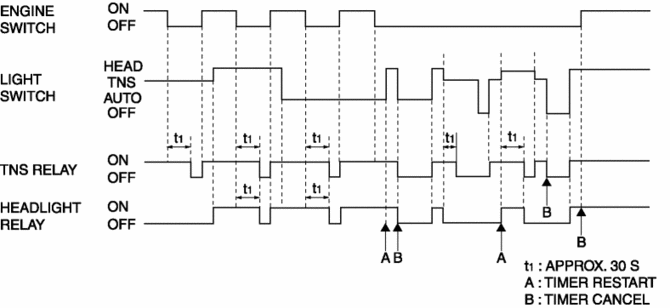Mazda CX-5 Service & Repair Manual: Auto Light Off System
Purpose
-
The auto light-Off system turns off the TNS or headlights automatically.
-
The front body control module (FBCM) performs auto light-Off system fail-safe..
Function
-
The auto light-Off system controls the front body control module (FBCM).
-
The front body control module (FBCM) controls the auto light-Off system based on the following signals and conditions:
-
IG power supply condition
-
TNS or headlight illumination condition
-
Light switch signal sent from start stop unit via CAN signal
-
If the front body control module (FBCM) detects that the ignition is switched off when the TNS and headlights are turned on, the TNS and headlights are turned on for a certain period of time and turned off after a certain period of time has elapsed.
-
A personalization feature has been adopted which can change the illumination time of the TNS or headlights. For details on the personalization features, refer to LIGHTING SYSTEM PERSONALIZATION.
Structural view

System wiring diagram

Operation
-
If the front body control module (FBCM) detects that the ignition is switched off when the light switch is in the TNS/HEAD/AUTO position and the headlights are turned on, the TNS or headlights are turned on for 30 s*1 and turned off after 30 s.
-
If the front body control module (FBCM) receives the light switch signal from the start stop unit during the auto light-Off system operation, the headlight is controlled as follows:
-
Light switch switches to TNS/HEAD signal: Illuminates the light for 30 s after receiving the signal.
-
Light switch switches to OFF/AUTO signal: Turns off the light when receiving the signal.

*1 The illumination time can be changed by personalization. For details on the personalization, refer to LIGHTING SYSTEM PERSONALIZATION.
 Auto Leveling Sensor Removal/Installation
Auto Leveling Sensor Removal/Installation
1. Disconnect the negative battery cable..
2. Disconnect the connector.
3. Remove the bolts.
4. Remove the auto leveling sensor.
5. Install in the reverse order of removal.
6. Pe ...
 Auto Light System
Auto Light System
Outline
The auto light system automatically turns the TNS and headlights on/off according
to the illumination level above and in front of the vehicle.
The auto light system is contro ...
Other materials:
Steering Switch
Purpose, Function
Operation of the audio system and change of the instrument cluster display
can be changed are possible without a change in driving posture.
Construction
The steering switch is located on the spoke of the steering wheel.
The resistance is built into ea ...
Clock Spring Removal/Installation [Standard Deployment Control System]
CAUTION:
If the disc on the combination switch is deformed or has foreign material
adhering to it, performance of the steering angle sensor may be reduced, causing
abnormal operation. When handling the clock spring, be careful not to deform
the disc and make sure there is no foreign ...
On Board Diagnostic System PID/Data Monitor Inspection [Fw6 A EL, Fw6 Ax EL]
1. Connect the M-MDS to the DLC-2.
2. After the vehicle is identified, select the following items from the initialization
screen of the M-MDS.
a. Select “DataLogger”.
b. Select “Modules”.
c. Select “TCM”.
3. Select the applicable PID from the PID table.
4. Verify the PID da ...
